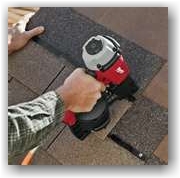You’ll find that the following information applies to to ne w roofs, re-roofing or roof repair. Depending on the task at hand you will employ specific tools and techniques to accomplish your goals. Some of the decisions you make will have to follow municipal guidelines and laws, while others will be determined by your personal preferences. There a many online resources for the details of how to best implement the processes in protecting the life and functionality of your roof system. The roofing techniques involved in laying down a new roof follow a fairly standard process. But first a little background on how a roof is composed.
w roofs, re-roofing or roof repair. Depending on the task at hand you will employ specific tools and techniques to accomplish your goals. Some of the decisions you make will have to follow municipal guidelines and laws, while others will be determined by your personal preferences. There a many online resources for the details of how to best implement the processes in protecting the life and functionality of your roof system. The roofing techniques involved in laying down a new roof follow a fairly standard process. But first a little background on how a roof is composed.
Roof Composition:
The first layer of your roof system is the sheathing. These are the plywood sheets you can see attached to the rafters in the attic. These provide the foundation upon which the rest of the system is built. The next layer added is called the underlayment. There are a variety of materials used during this technique with the most common being builder’s felt.
This second layer is now required in municipal codes and provides added protection from the elements. The valleys, eaves, rakes and protrusions all get an application called flashing. This technique directs water away from these vulnerable spots. The final step in roofing techniques is laying down the outer covering. These options include many varieties of materials and styles.
How To Address the Repair:
Now you know the basics of how a roof is composed, let’s look at how to address a repair. First you need to identify the problem. Once you have identified a problem, you should research the specific recommendations for addressing the concern. Do not let the problem continue as this will result in more serious damage that will be costlier and more time consuming to fix.
How to you identifie the problem? If you have noticed a leak inside, go to the attic and search for the exact location of the problem. You can use a screwdriver to check the wood for rot in determining what degree of repair is needed. If you must replace shingles or tiles on the roof, learn the specific techniques for your particular materials.
When you find damage, you need to remove the damaged shingles first thing. If it is raining out or if the weather is bad, you may want to put a few shingles over the existing ones until you can get on the roof and do the repair correctly. Keep in mind this is a temporary fix and the following steps should always be done as soon as possible.
Once you have removed the old shingles, you need to make sure the tar paper is not ripped or damaged as well. If it is, you need to replace that before you continue with the roof repair.
When you do have some damage, you want to take care of it as soon as possible. This is going to keep the rest of the roof from sustaining more issues that may need to be taken care of. This is also going to keep the interior of the house free from water leaks and other damage that is associated with having a poor roof.